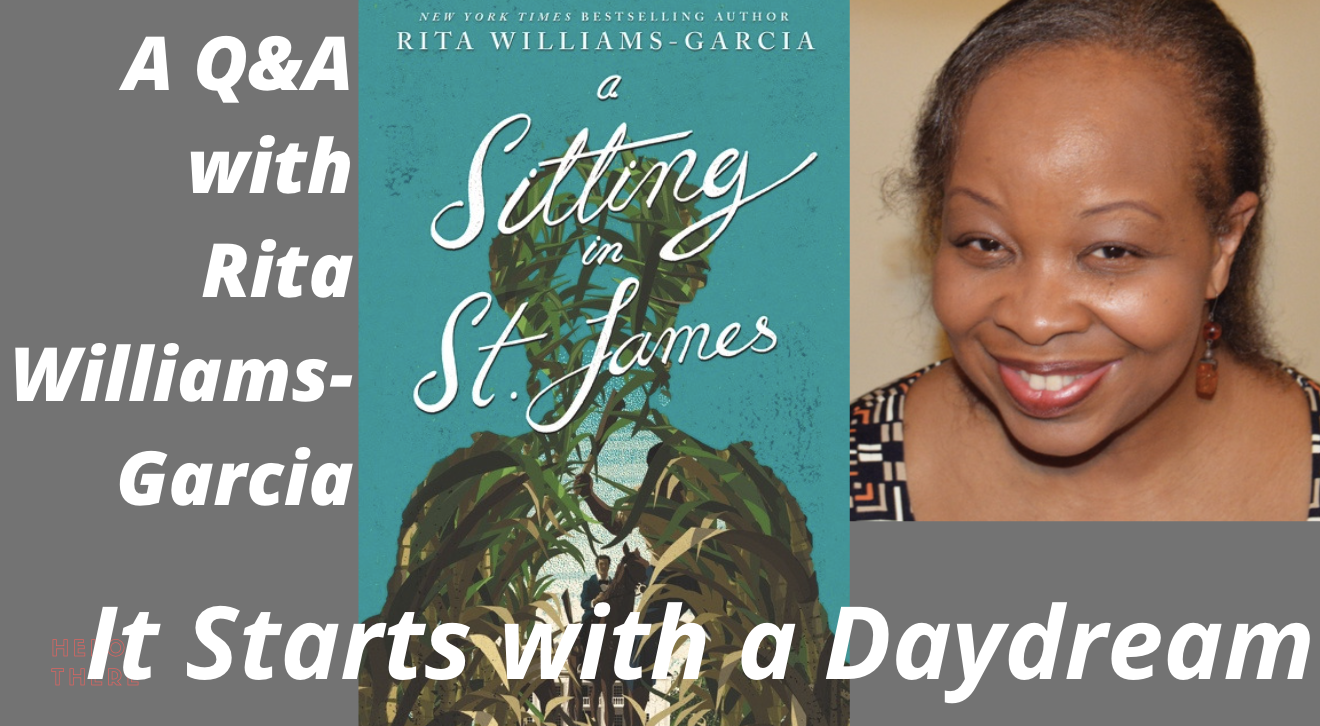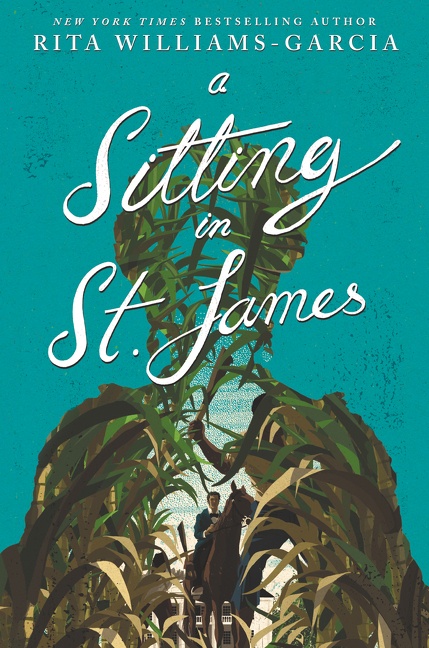interview by Anne-Marie Strohman
I have known Rita Williams-Garcia mostly through her voice. As a student in Vermont College of Fine Arts’ program in Writing for Children and Young Adults, I had access to a treasure trove of lectures from past years. Though my time at VCFA did not overlap with Rita’s time there as faculty, I listened to many of her lectures over and over. Each one contained gems that I use in almost every writing session. Her voice stays with me, even though we’ve never met. So I was thrilled to have the opportunity to find out more about Rita’s writing process, her approach to craft, and the secret sauce that makes her novels sing. Prepare to be inspired. –Anne-Marie
KidLit Craft: In other interviews, you’ve talked about the inspiration for the book being the character of Byron, a dream that you used (for yourself) as Hannah’s backstory, and the question from a child at a panel, “why do they hate us?” Is this kind of multiple-pieces approach typical for your novels, or was this a new experience?
Rita Williams-Garcia: Usually, several things or reoccurrences conspire to make me tell a story. With LIKE SISTERS ON THE HOMEFRONT, it was a pregnant girl in my sophomore class; a twelve-year-old holding who I thought was her baby brother–wrong! And finally, a four-year-old feeding her baby brother with the expertise of a weary mother. It was the latter that got me writing, but the two images from my younger years went into creating the character of Gayle. I have to be pushed, haunted or both. I must be convinced there is a story beyond the obvious surface story. It’s got to compel me. And then I’m off! Daydreaming and writing.
KLC: Writers often struggle with where to start the story. In A Sitting in St. James, you start with Madame Sylvie’s marriage at 13 to escape the violence against the aristocracy during the French Revolution. Was that an early choice, or one made in revision? How did you decide where to start the story?
RWG: I’m a big daydreamer. My characters appear, speak, wander in and out of my consciousness when I daydream. (They fold their arms and look away when I plot.) I daydreamed about the older Madame Sylvie telling her granddaughter a fairytale version of her introduction and marriage to Bayard Guilbert. I imagined what she might have said about the cabbage, versus the reality of the gift and ultimatum. But I’m jumping ahead of myself! Because I was thinking about Byron, that he was from Louisiana, I had to know his family’s background. How his family came to Louisiana. That they fled from not one revolution, but two. These all occur in daydreaming as I try to understand the origin of my characters. What does not come from research, comes from daydreaming. Both happen before I begin to write.
KLC: It makes sense that for an epic story, you would need an omniscient narrator. What benefits did you gain from an omniscient POV? Were there any drawbacks?
RWG: I used omniscience for A SITTING IN ST. JAMES to mirror storytelling of the period. But omniscience also let me disclose information known and unbeknownst to the characters. I jumped over the hurdles of time within a few pages, from pre-colonial Louisiana territory, to the French Revolution to Haiti, and then to present day Louisiana. Each main character had their own space–some with more depth than others. Honestly, one of the best parts of writing the story was employing the direct address of the all- knowing, all-seeing narrator, who stepped in with background info, planted clues and begged for patience along the way of the story. I enjoyed her!
The main drawback for me was in conveying the depth of emotion that might be better handled in close third or first person. At one point, I couldn’t let Thisbe’s inner life be shrouded. The narrator steps out and speaks directly to the reader: “The answer is rage.”
KLC: In your interview with Cynsations, you mention seeing or hearing a scene. Can you tell us more about that experience and how you approach drafting?
RWG: Did you watch Star Trek? Remember the transporter? “Lock onto my coordinates. Beam me up.” I fully transport myself from my reality into the world that I seek to create. In a word, I daydream. Deeply. I put myself with the character, close to the character, sometimes in the character, to taste the dirt when they’re in the dust storm or feel the scratchy bristles of cane stalk whip my face. Then I write it. Later, I make adjustments, because what I have to understand is different from what the reader should feel. Sometimes I have to rein it in or pull back. It’s not always the point that the reader should feel each and everything—but the writer must!
KLC: Many people have commented on the humanity of your characters–that none, not even those who do monstrous things, are caricatures. How do you develop your characters to present that humanity on the page?
RWG: Easy! Even though most do not make it onto the page, origin stories of main characters are essential to my understanding of them. But when it comes down to it, I ask what do they want? Why can’t they have it? How do they humanly respond to their condition? (Humanly, versus how I might manhandle them in the plotting.) Even when I don’t like my characters, I have to understand them.
KLC: You’ve talked in the past about the importance of breath and rhythm, and how they inform sentences. Did those ideas come into play while writing A Sitting in St. James?
RWG: Yes, indeed! But in my head as I wrote were the various types of music that personified culture and histories. The hard-clapping Stephen Foster songs that Lucien would have liked–a far cry from his mother’s tastes in European classical–the Balfa Brother’s Cajun style, the Creole style, the African, the French Catholicism and the Louisiana Creole Catholicism. They created rhythms in my head while I wrote. Song. Breath. Syncopation. I generally get close to my characters when I felt them breathing. I feel it when they hold their breath or breathe shallow. I learn their rhythms. Each character, and for that matter, every room or place has its own sound or song on the soundtrack of the book.
KLC: There are so many detailed objects that carry meaning in this story–the obelisk that Lucien is attempting to move at the beginning, the hairbrush that Thisbe uses to groom Madame Sylvie and that has also been used to beat her. How intentional are you with these objects when you’re drafting? When you’re revising?
RWG: I truly believe if you know what you are writing about, every song, every fork, every shoe, every choice will reflect your themes. Your subconscious is your greatest heavy lifter in the toolbox. Once you surround yourself in the world of your story, all of the items that create texture and detail will naturally appear in that world. Although, up front, I did see the obelisk as a Beowulf type monument to futility, Madame’s throne as a false throne, and the portrait as a remnant of a deposed archaic way of life, and the ultimate cause of the Guilbert family’s destruction. My main game pieces were on the chessboard up front in the plotting. It’s the details that give main pieces character.
KLC: Your novel is about big things–human enslavement, power, generational conflict, autonomy, culture–and yet it is also about the minute–a list of names in a newspaper, an individual portrait. How do you think about the big and the small as you’re writing?
RWG: The characters save me each and every time! I can either write about the great subjects or the characters. I choose the characters, their peculiarities, their mundanities, their wants and their humanness, or faults. Everything else around them is setting.
KLC: In your author’s note, you are specific about your commitment to handling the stories of enslaved people, as one reviewer phrased it, “with care and hope.” Sometimes people think of “care” as shielding readers from hard things, but you care for them by telling them the truth of history and the truth of these characters. How did you think about your audience as you were writing and revising this book?
RWG: I split myself in two when I write historical fiction. One part writes what was and how it was. Plain. Empirical. The other half of me is aware that I am writing for twenty-first century readers with their social awareness and concerns in mind. And that there are gatekeepers. While many writers can combine both parts and push forward, I can’t. The latter half is aware of her young audience, ages 16 plus. The content, the truth is there. We don’t skirt around the life of the enslaved under the rule of the slaveholder. My way was to introduce my characters and the scenes as naturally as I could, without melodrama. I carried with me the idea that this was everyday life, attitudes and responses. Even though 1860 Louisiana isn’t part of my cultural background, I worked to not write as the tourist that I was. (It helped tremendously to have real Louisiana Creoles to vet the story!) Although the harder scenes are there, my goal was never to shock or bombard the reader. As an adult novel, A SITTING IN ST. JAMES would be fairly light; for upper teens, the novel is near, if not on the edge. (In terms of setting boundaries, I considered Margo Lanagan’s TENDER MORSELS, a novel also aimed at upper YA readers.) Part of my self-discussion involved books I’ve read! Anyway, If I created a sense of “this is life”—regardless of my own shock and rage–my hope was the reader would better see life on both sides with clarity.
KLC: You’ve talked in interviews about the year of research you did for the book. What’s something you discovered in your research that fascinated you that didn’t make it into the book?
RWG: Tons! Just tons! Here’s one: Catholic priests made pleas to King Louis XIV to send virtuous young women to the French outposts in what we now know as Louisiana, Mississippi, and Alabama for French male colonists to marry and maintain a French Catholic society. Convicts and prostitutes wouldn’t do. The young women, ages 14-19 were orphans, poor, and virgins who arrived carrying little wooden suitcases, some have said, shaped like caskets. In their months-long journey across the Atlantic, they stopped in Haiti to refuel–another aspect I wanted to strengthen: the France-Haiti-Louisiana triangle that I sought to bring into the novel. Anyway, these girls were called casquette girls, filles à la cassette (girls with suitcases), and pelican girls, but were commonly called ‘casket girls.’ I wanted to refer to this forgotten history, but it could have only come up as trivia, since Madame arrived in the early 19th century, and the casket girls arrived in Louisiana in the early 1700s. The trunk was stuffed; I didn’t dare add more to the novel.
KLC: How did your time teaching in the Writing for Children and Young Adults program at Vermont College of Fine Arts impact your writing and you as a writer?
RWG: First, being on faculty at VCFA was everything I needed after I quit my job of twenty-five years at a software and media/marketing company. Prior to that, my writing life suffered. If I did an author’s talk, I’d refer to books as “the data” and readers as “respondents.” This immersive craft and literary environment deprogrammed me in the best possible way. I was breathing the air I needed to breathe, surrounded by readers and writers, and at last, reading children’s and YA books by the hundreds. While I had an MA in Creative Writing, being at VCFA gave me the language to communicate with my colleagues and apprentice writers and in turn, gave me the language and insights to coach my own writing. I could always read my own work and know where it was weak, lagging, etc. But the ability to articulate these issues also gave me the means to approach revision.
KLC: Rita, thank you so much for sharing your wisdom with us! What can Rita Williams-Garcia fans look forward to next?
RWG: About eleven years ago, right after I wrote ONE CRAZY SUMMER, I switched gears and wrote a gaming novel. It was, to say the least, inscrutable! Over a decade later, I finally dug deep into the revisions and will soon be able to share THE PLACE OF ALL GAMES and its sequel. This departure from works my readers are familiar with is a homage to the games of strategy I played with my brother back in the day. It was fun to let my nerd flag fly and to hopefully encourage readers and writers alike to try something different!

Rita Williams-Garcia is the New York Times bestselling author of novels for young adults and middle grade readers. Her most recent novel, A Sitting in St. James, is geared toward older teens and adults. Her novels have been recipients of numerous awards, including the Coretta Scott King Award, National Book Award Finalists, Newbery Honor Book, Junior Library Guild, and the Scott O’Dell Prize for Historical Fiction. She served on faculty at the Vermont College of Fine Arts Writing for Children MFA Program, and she resides in Queens, New York.
You can find her at https://rita-williamsgarcia.squarespace.com/
Anne-Marie Strohman (co-editor) writes picture books, middle grade novels, and young adult short stories and novels. She is trained as a teacher, an editor, and a scholar, specializing in Renaissance Literature. She holds an MFA in Writing for Children and Young Adults from Vermont College of Fine Arts and is an active member of SCBWI. Find her at amstrohman.com and on Twitter @amstrwriter.


Love this interview! So informative and inspiring. Thanks A-M!